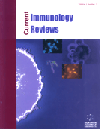- Home
- A-Z Publications
- Current Immunology Reviews (Discontinued)
- Previous Issues
- Volume 3, Issue 2, 2007
Current Immunology Reviews (Discontinued) - Volume 3, Issue 2, 2007
Volume 3, Issue 2, 2007
-
-
Pathogenesis of Type 1 Diabetes: Regulation of Adhesion Molecules and Immune Cell Trafficking
More LessAuthors: Jordana Cohen, Krishnan Sundar and David BleichTargeted pancreatic β-cell destruction by activated immune cells is a hallmark of type 1 diabetes in human beings and rodents. Activated T-lymphocytes, B-lymphocytes and antigen presenting cells all migrate to the pancreatic islets and orchestrate a β-cell specific inflammatory immune response. While the timing and sequence of these invading, migratory cell populations are undoubtedly critical and fundamental to our Read More
-
-
-
AIDS Vaccines and Reproductive Immunology
More LessIt may appear that problems of reproductive immunology have little in common with issues of treatment and prevention of AIDS. However, the certain aspects of HIV immunopathogenesis are closely related to problems faced by reproductive immunologists. The development of prophylactic and therapeutic AIDS vaccines would greatly benefit from acquired experience in immune regulation of reproductive dysfunction. The s Read More
-
-
-
Platelets as Potential Immunomodulators: Is There a Role for Platelet Toll-Like Receptors?
More LessAuthors: Fabrice Cognasse, John W. Semple and Olivier GarraudPlatelets are anucleated cells that are fragments of megacaryocytes, and they play a unique role in primary haemostasis. As they also contain numerous secretory products, they can exert crucial roles in several aspects of haemostasis. Furthermore, they contain and secrete a variety of cytokines, chemokines and associated molecules, which behave as ligands for receptors/counterparts displayed by both endothelial cells Read More
-
-
-
Cellular and Molecular Regulation of Inflammatory Pain, Nociception and Hyperalgesia - The Role of the Transcription Factor NF-κB as the Lynchpin Nocisensor: Hyperalgesic or Analgesic Effect?
More LessThe milieu of inflammatory cells and inflammatory mediators is crucially involved in the genesis, persistence and severity of pain following trauma, infection or nerve injury. The mechanisms and pathways mediating pain and nociception (hyperalgesia) are transcriptionally regulated. The transcriptional mediator nuclear factor (NF)-κB plays a major role in regulating inflammatory responses, ostensibly via the control of gen Read More
-
-
-
Bacterial Infections of the Central Nervous System: A Critical Role for Resident Glial Cells in the Initiation and Progression of Inflammation
More LessAuthors: Vinita S. Chauhan and Ian MarriottWhile bacterial infections of the central nervous system (CNS) constitute a group of serious and often life threatening diseases, the pathophysiology of these diseases remains poorly understood. Resident glia have traditionally been considered to be victim cells during bacterial infections, but it has become increasingly apparent that resident cells of the CNS have the potential to contribute to the initiation and/or progression of in Read More
-
-
-
Lipid-Specific Immune Responses Against Tuberculosis: From Basic Science to Medical Applications
More LessAuthors: Isamu Matsunaga and Masahiko SugitaMycobacteria are unique in that their thick cell wall contains a variety of lipid and glycolipid components that are critical for survival and virulence of the microbes. Studies over the past decade have established that our immune system has evolved an outstanding ability to elicit immune responses directed specifically against these highly hydrophorbic lipid antigens. Unlike MHC molecules that bind peptide antigens, huma Read More
-
Volumes & issues
Most Read This Month
Article
content/journals/cir
Journal
10
5
false
en


